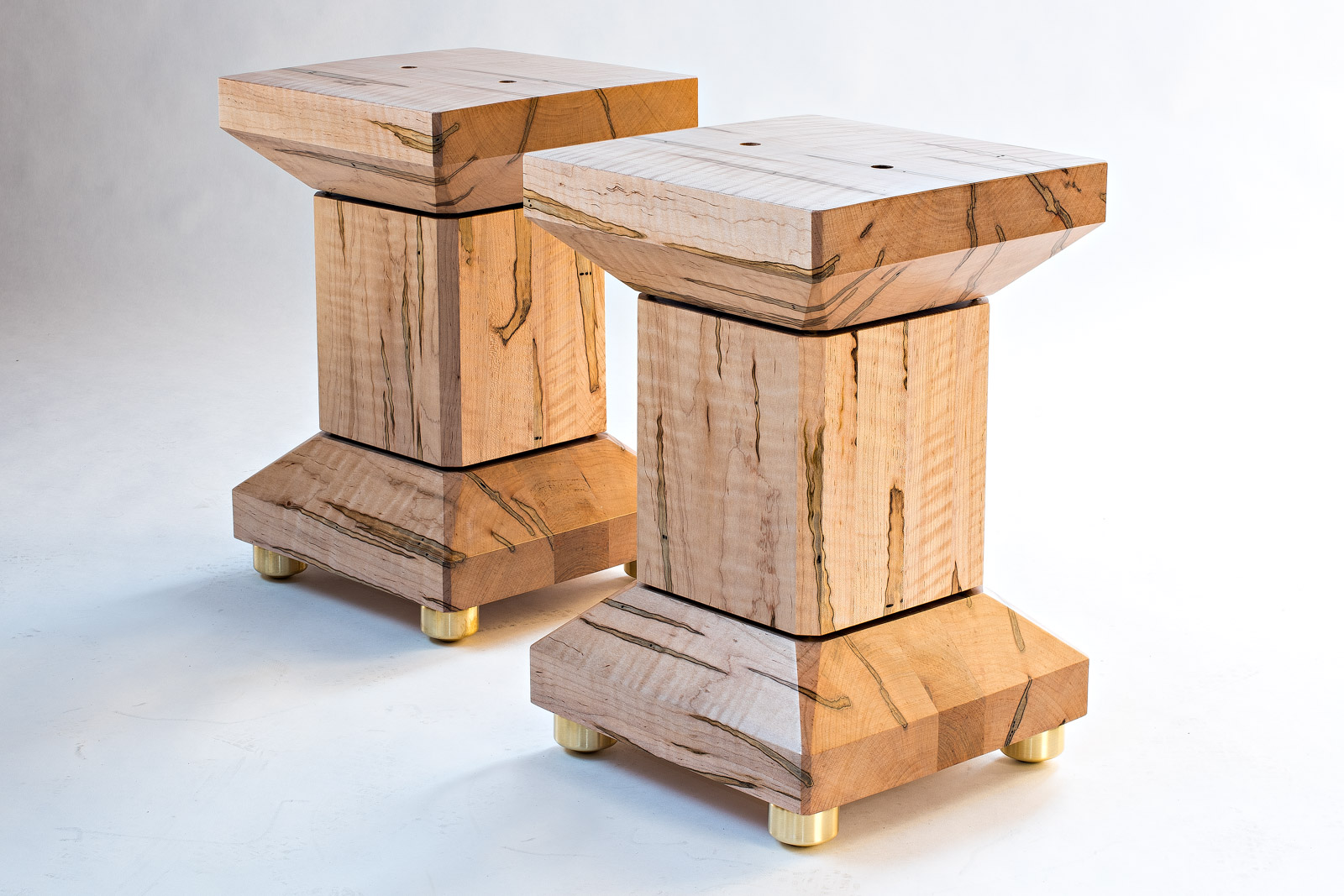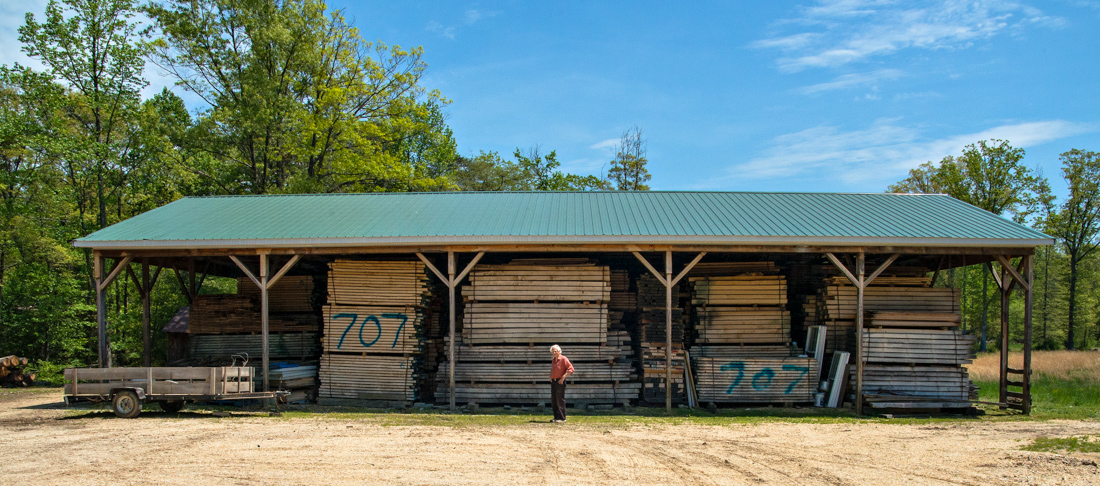Why Ambrosia Maple?

How Speakers and Electronics Are Mounted Affects How They Sound
In mounting a component, our Amish-crafted, solid maple platforms, speaker bases, and SAMSON rack shelves all serve the same function: they are the vibration-absorbing element in our Vibration Control System, a demonstrably proven approach that has transformed the sound of thousands of audiophile systems over the years.
Putting your audio gear on a really good vibration-absorbing base beautifully upgrades the sound. Our painstaking R&D listening tests proved that maple sounds warmer, clearer, punchier and more detailed than any of the commonly used platform and stand materials:
• MDF is the worst sounding wood product; it kills treble, smears detail and produces thuddy bass. Plywood is a slightly better but still way behind solid maple.
• Glass, granite, or slate are even worse sounding than MDF and make treble sound harsh while weakening and dulling the bass.
• Hi-tech damped composites strongly deaden overtones and dynamics.
• Myrtle or exotic tropical hardwoods sound better than plywood but are tonally colored and suppress detail.
This is confirmed unequivocally by nearly two decades of head-to-head shoot offs by skeptical customers. Adding our uniquely shaped brass footers to drain vibration efficiently and cleanly out of your component and down into the air-dried maple doubles the sonic improvement.
When supporting a musical instrument's vibrating soundboard, maple’s sonic superiority over all other woods is old news to every violin and piano maker since Stradivarius and the earliest Steinways. Master instrument builders taught us to always use air-dried rather than kiln-dried maple. The kiln’s high heat weakens the wood’s fibers, thereby deadening sound. Air-dried maple is less colored and closer to the sound of our master tapes than any other platform material—audibly better than harder or softer or denser woods, and notably better than kiln-dried maple or, worse yet, maple butcher block (excessively damped by its multitude of glue joints).
We Only Use Ambrosia Maple Air-Dried For 3 to 6 Years For Our Upgrade Products
Because finding air-dried 2" to 4" thick maple at ordinary lumberyards is impossible, we turned to a local Amish sawmill in 2001.They find us logs of very special maple indeed: 75 to 100 year old local Ambrosia maple that sounds distinctly warmer and clearer than Canadian rock maple. These slow-growing old trees yield wood of gorgeous character: exceptionally tight and variegated grain, lovely nut-colored contrasts, subtly shimmering curl, birdseye, tiger striped, and spalted grain.
We air-dry the sawmill's rough-cut heavy planks for 3-6 years, depending upon the thickness. Our family of Amish craftsmen oversees this painstaking drying process. The photo above shows the huge drying shed—with Pierre standing in front of about 125,000 board feet of the selected Ambrosia maple that goes into Mapleshade’s carefully crafted platforms, racks and stands.
Ben, with his sons Crist and Uri, meticulously plane, bevel, shape, sand and hand-finish all our wood products. The three of them take amazing care to ensured the beauty of their workmanship matches the exceptional performance we demand of our designs. Their hand-sprayed satin lacquer finishes handsomely show off the dramatic character of our old-growth Ambrosia maple. Take a look at Ben's impressively equipped shop in our Handcrafted Amish Production Gallery.
Ambrosia Maple Used For Our Modular Furniture Is Locally Kiln Dried
The wood used for our striking-looking Ambrosia maple modular shelves and their accessories comes from the same Amish sawmill that sources our maple lumber. After rough-cutting, this maple is conventionally dried by the kiln used by other furniture makers in the Amish community. Though the drying is different, our modular furniture is hand finished with the same clear satin lacquer to match our air-dried upgrade products.
What is Ambrosia Maple?
Ambrosia Maple is the traditional name for a form of red maple found locally in Maryland and Virginia. It has distinctive long, tapered streaks running with the grain, streaks of a contrasting brownish or slightly purplish-grey hue. This striking coloration is also sometimes called Ghost Maple or Wormy Maple. At the head of each of these beautiful streaks is a pair of tiny holes bored by the adult Ambrosia beetle in which to lay its eggs—and to simultaneously lay down a unique fungus species. The eggs hatch into larvae that are incapable of digesting the maple; instead, they cultivate and feed on the fungus which flourishes by digesting the maple for the larvae, a remarkable example of nature's symbiosis. The tree's sap carries away the “runoff” from each larva's miniature mushroom farm, thus creating the pattern of lovely long stains that characterize this unique form of maple. There are no larvae left after the 3 to 6 years of drying; they all develop into adult beetles and fly away within a couple of months after the eggs are laid in the living tree.
The small holes and their associated streaks appear to varying degrees across all of our maple products. Besides their striking looks, they actually slightly enhance the maple's sonic performance. Because of the inherently variegated grain and patterning of Ambrosia maple, every platform, stand and shelf we manufacture is unique. We show a representative sampling of these natural grain and coloring variations in our Ambrosia Maple With Clear Finish Gallery.
© 1990-, Mapleshade Productions or its affiliates
